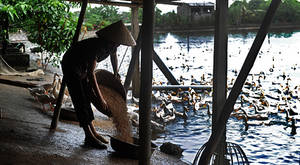
18 Jan, 2014
Food aplenty, but 840 million people still go hungry every day – FAO
17 January 2014, Berlin, FAO media release – Creating healthy and sustainable food systems is key to overcome hunger and malnutrition around the globe, said Helena Semedo, FAO Deputy Director-General at the Green Week in Berlin today.
“Food production has tripled since 1945 and average food availability per person has risen by 40 percent,” Semedo said at the Global Forum for Food and Agriculture 2014. “But there are still huge flaws in how the globe’s food systems operate, and we have to increase our efforts to fix these problems.”
 |
|
|
Strong and resilient food systems are the most cost-efficient and sustainable way to prevent all forms of malnutrition.
|
The international community is facing several nutrition-related challenges, Semedo said. The health of more than half of the world’s 7 billion is affected by under- and overconsumption.
Despite the abundance of food supplies, there are still 840 million people that go hungry every day. This affects their ability to work, it negatively impacts the development of their children, exposes them to illness and leads to premature deaths. The health of another two billion is compromised by nutrient deficiencies.
On the other hand, another 1.5 billion people are overweight or obese, consuming more food than their bodies need and exposing them to greater risk of diabetes, heart problems and other diseases.
Semedo also underlined that much of the high food output achieved in the past has placed great stress on natural resources. It has degraded soils, polluted and exhausted fresh water supplies, encroached on forests, depleted wild fish stocks and reduced biodiversity.
“Intensive farming systems, combined with food wastage on a massive scale, have also contributed to greenhouse gas emissions,” she said.
Healthy food systems for healthy people
“Our common approach to food production is simply not sustainable today, or in 2050, when we will have to provide food for a population of 9.6 billion people. Fortunately we have the means to drastically change our production systems and consumption patterns, that means creating healthy food systems for healthy people,” she said.
“Creating strong and resilient food systems, that take into account the special needs of women, is the most practical, cost-efficient and sustainable way to address and prevent all forms of malnutrition.”
“We need to produce nutritious food for all people today while also protecting the capacity of future generations to feed themselves. Nutrition must become one of the primary objectives of food system policies and interventions, ensuring a diverse, balanced and adequate combination of energy and nutrients.”
The priorities for agricultural research and development must become more nutrition enhancing, with a stronger focus on nutrient-dense foods such as fruits, vegetables, legumes and animal-source foods, as well as local biodiversity and diversified farming systems.
At every stage along the way, from farm to fork, resources must be used efficiently, Semedo emphasized. Getting the most food from every drop of water, plot of land, speck of fertilizer and minute of labour saves resources for the future and makes food systems more sustainable.
An additional challenge is to manage livestock production sustainably. Demand for livestock products will grow 70 percent by 2050. Consumption of meat, milk and eggs is growing rapidly in developing countries, providing nutritious diets to previously food insecure populations.
“The livestock sector improves livelihoods and creates economic growth and incomes in rural economies. However, livestock is also associated with its contribution to climate change, land use change, and disease transmission. Managing the livestock sector sustainably is crucial. Building an international coalition of stakeholders committed to working together to improve the environmental performance of the livestock sector is therefore key,” Seemdo said.
Better governance
“All key sectors and players throughout the food system must be involved to make better use of food systems for improved nutrition. This requires better governance, based on sound data, a common vision and, above all, political leadership.”
Consumers need help to make healthy food choices. Promoting behavior change through nutrition education and information has proved effective. Behavior change can reduce food waste and contribute to the sustainable use of resources.
Investing in better nutrition also leads to strong economic returns, the FAO Deputy Director-General stressed. “If the global community invested $1.2 billion per year for five years on reducing micronutrient deficiencies, the results would be better health, fewer child deaths and increased future earnings. It would generate annual gains worth around $15 billion – a benefit to cost ratio of almost 13 to 1.”



Liked this article? Share it!